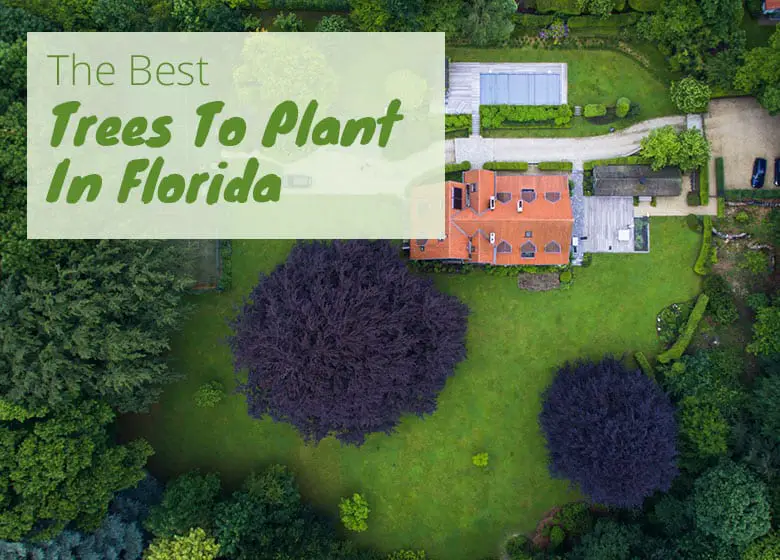Gardeners have a wealth of choices in ground covers that are hardy growing in all areas of the state. Ground covers can add color, texture and an interesting appeal to the garden.
Beach Sunflower, Bromeliads, Dianthus, jasmine minima, juniper, perennial peanut, mondo grass, sunshine mimosa, and sweet potato are some of the best ground covers that you can grow in Florida.
Whether you’re looking for natives, those that quickly spread or tolerate shade, drought or salty conditions there’s something to suit your fancy.
Nine of the Best Ground Covers for Florida
Below are some of the best and most popular ground covers that grow well in Florida landscapes.
Beach Sunflower
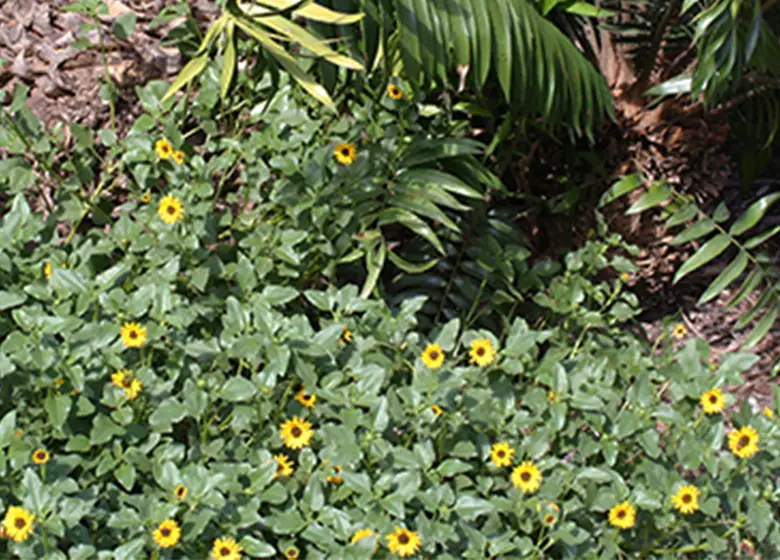
A Florida native, beach sunflowers (Helianthus debilis, USDA zones 8b to 10b) is sure to add a cheery appeal used as a ground cover in gardens throughout the state. Evergreen mounds of glossy green leaves fill spreading branches with plants growing around 1 to 4 feet tall and 2 to 4 feet wide. Bright yellow, daisy-like flowers with brown centers bloom year-round, adding a constant blast of color wherever utilized.
With beach sunflower’s tolerance to drought and salty conditions, it makes a durable ground cover used directly along the dune or in drought-tolerant gardens. It also adds year-round color to borders, mixed gardens or planted in mass to quickly fill in a bare area. For the best growth, plant in full sun and in loose, well-drained soils.
Bromeliads
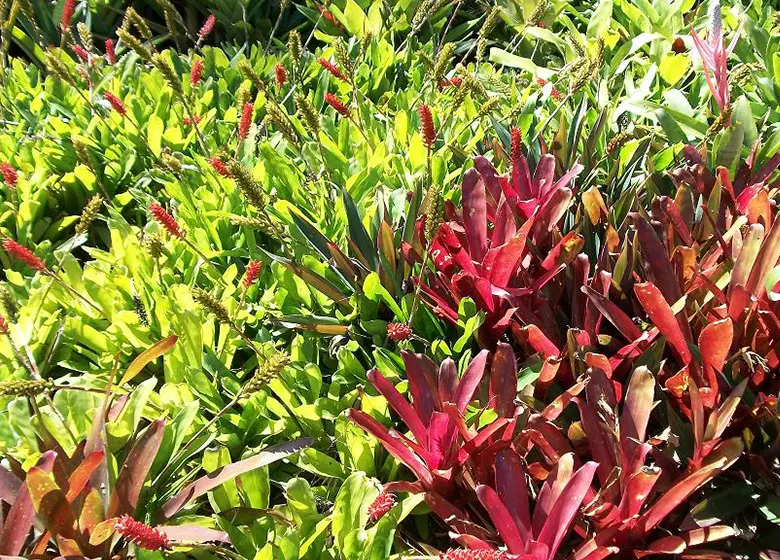
Bromeliads add an instant tropical feel wherever used in the landscape as ground covers. One trip to your local garden center and you’ll find multiple varieties available that grow well as landscape plants in frost-free areas of Florida. Foliage color differs and be green to orange with differing patterns and the blooms are as unique as they are beautiful. Two common varieties are Aechmea distichantha, with green straplike leaves and producing a flower stalk 2 feet tall containing attractive red bracts. Aechmea blanchetiana has orange leaves with red tips and produces a showy flower cluster composed of yellow and red bracts. Both bloom in spring and are hardy in USDA zones 10 to 11.
Bromeliads are attractive used as a ground covers planted in mass, used along a border, walkway or used as accent plants. They also perform well planted in pots or grown indoors. For the best growth plant in shade to partial shade and in well-drained soils. Plants have a high drought-tolerance and low tolerance to salty conditions.
Dianthus
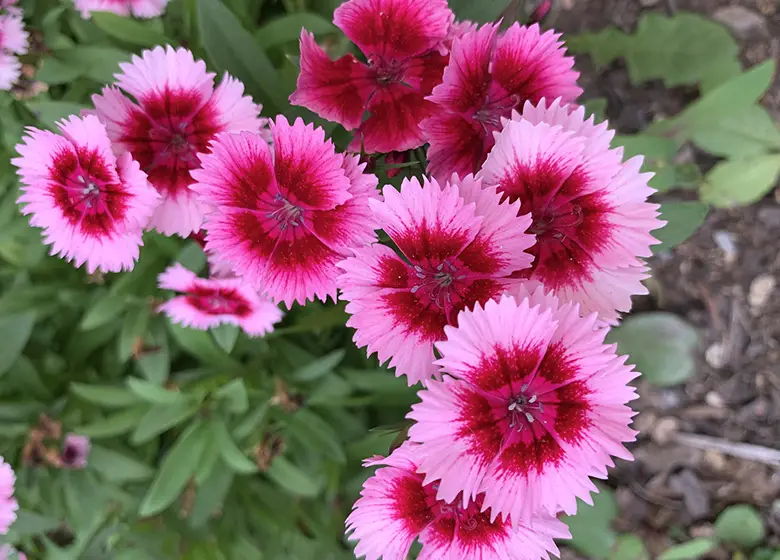
With their cheery carnation-like blooms, dianthus (Dianthus spp.) makes attractive ground covers when planted in mass. They perform best planted during the cooler months of fall, winter and spring in Florida and don’t grow as well during the hot summer months. Plants perform as short-lived perennials, annuals or biennials depending on the species. All produce showy green foliage on plants slowly growing anywhere from 6 inches to a foot tall. The slightly fragrant flowers range in colors of white, red, pink, salmon, lavender and purple and add a colorful appeal wherever used.
Dianthus planted in mass and utilized as a ground cover is sure to grab the eye’s attention and brighten the area with color. For the best performance, grow dianthus in a sunny to partially shady location and in fertile soil that drains well. Water regularly for the best growth.
Jasmine Minima
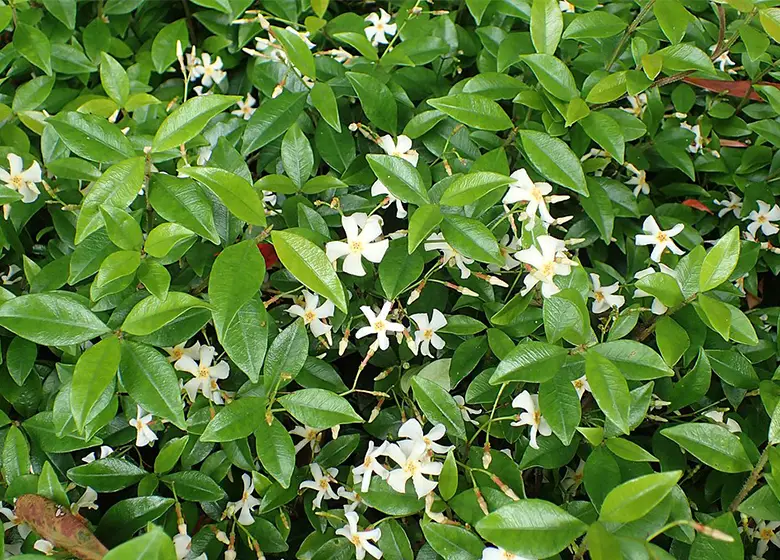
For a sturdy and durable ground cover that stands up to what Florida can dish out without skipping a beat you can’t go wrong with jasmine Minima (Trachelospermum asiaticum ‘Minima’, USDA zones 7b to 10) also called Asiatic jasmine. The fast-growing ground cover is hardy growing in all areas of the state. Plants form a dense and tangled mat filled with small leaves that have a red tinge when young eventually changing to glossy green. Mounds grow anywhere from 3 feet wide to up to 18 inches tall.
Minima quickly fills in bare areas of the landscape or adds a field of green before you know it. It also works well as an alternative to turfgrass. For the quickest growth, plant the evergreen in full sun but plants also grow well in partial shade although at a slower rate. Grow in well-drained soils and once established, plants have a moderate tolerance to drought and salt.
Juniper
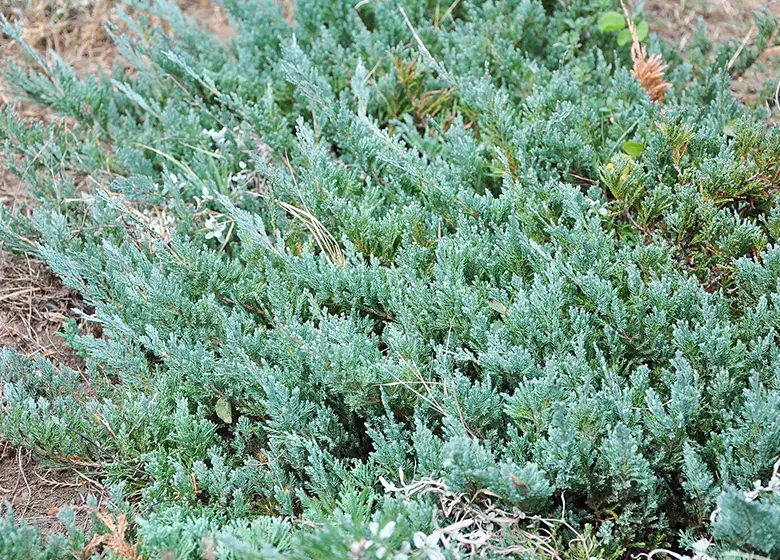
Forming a dense mat of green, needle-like foliage, shore juniper (Juniperus conferta, USDA zones 5a to 10b) makes a great ground cover for gardeners statewide. The evergreen creeps along the ground slowly forming spreading mounds growing around 1 to 2 feet tall and with a spread of up to 10 feet. The glossy green needle foliage becomes softer as plants age and is prickly while young.
Shore juniper makes a hardy and durable ground cover used along borders, walkways or as edging plants. It also works well growing as an erosion preventer planted on slopes or even along the dune. However, it is flammable so don’t plant close to a structure. For the best growth, grow this drought- and salt-tolerant evergreen in full sun and in well-drained soil.
Perennial Peanut
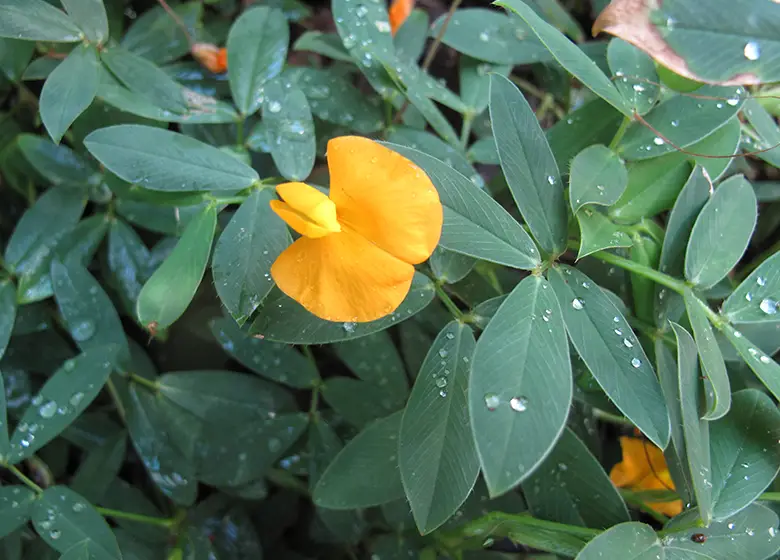
For a though perennial ground cover that flowers and stands up to Florida’s harsh conditions, gardeners throughout the state should try perennial peanut (Arachis glabrata, USDA zones 8b to 11). Spreading plants are covered in green, pea-like leaves, growing around 12 inches tall and spreading up to 8 feet. All through summer, plants fill with bright yellow pea-like blooms, giving plants a cheery appeal.
Gardeners can utilize this tough little plant to help curb erosion in areas or in a xeriscape, as plant stand up well to drought and salty conditions. It works well filling in bare areas, planted in mass or used along a border. For the best growth, plant perennial peanut in full sun and soil that drains well.
Mondo Grass
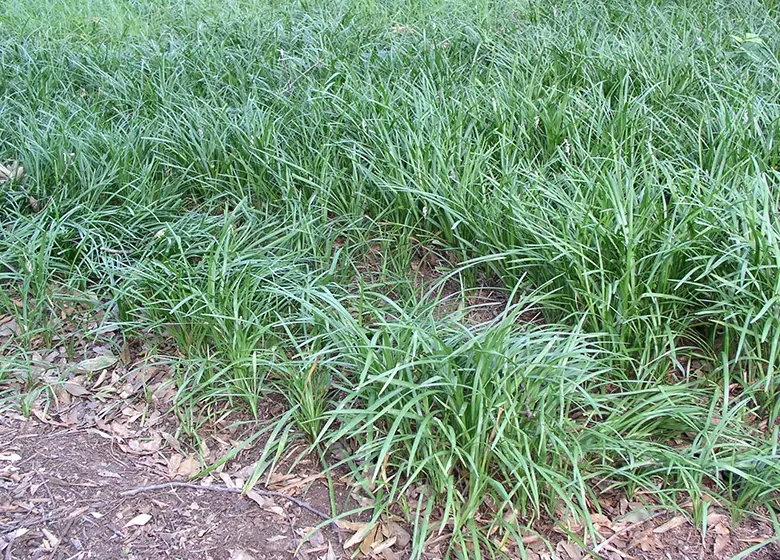
Also called dwarf lilyturf, mondo grass (Ophiopogon japonicus, USDA 7a to 11) is a popular evergreen border grass and ground cover growing well statewide. Plants produce glossy green, grass-like foliage on mounding plants growing around 1 feet tall and up to 2 feet wide. In summer, plant produce insignificant white flowers that then form into purplish round berries that are attractive against the dark green leaves.
Mondo grass is a great filler plant to add color to a shady or partially shady garden. It’s attractive used as an edging or border plant and also is attractive planted in mass. For the best growth plant modo grass in a partially shady to full shade location and in well-drained soil. Plants have a moderate tolerance to both drought and salty conditions.
Sunshine Mimosa
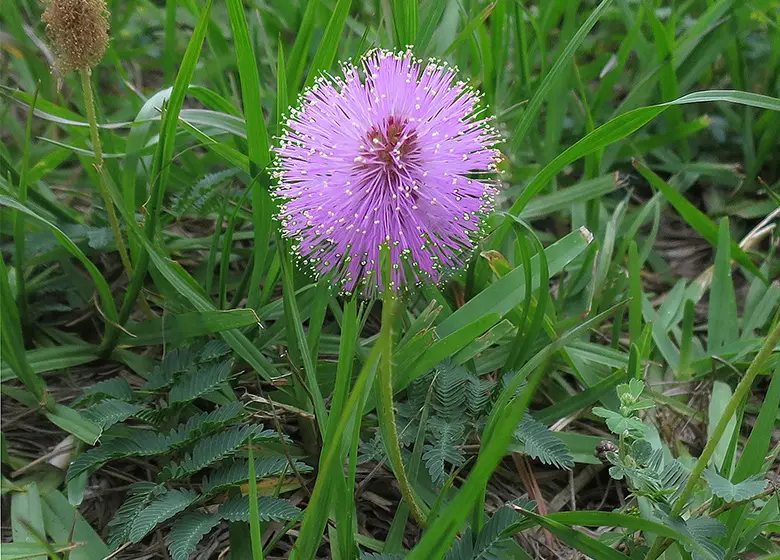
Also called powderpuff mimosa, sunshine mimosa (Mimosa strigillosa, USDA zones 8a to 11) can grace gardens with its cheery flowers statewide. This Florida native ground cover sports small, fine-textured and feathery, green foliage with the fast-spreading perennial growing 6 inches tall and spreading up to 10 feet. Year-round, plants fill with small, pink, puffy blooms standing upright on short stems, filling the plant with a sea of calming color.
Sunshine mimosa’s hardiness makes it suitable used as a lawn replacement, as it takes well to mowing. It also works well used in native gardens or as a filler ground cover. It’s the larval food for some butterflies, so it makes a good addition to pollinator gardens. For the best growth and flowering, grow sunshine mimosa in full sun to partial shade and in well-drained soils. Plants are moderately tolerant to drought and salt spray.
Sweet Potato Vine
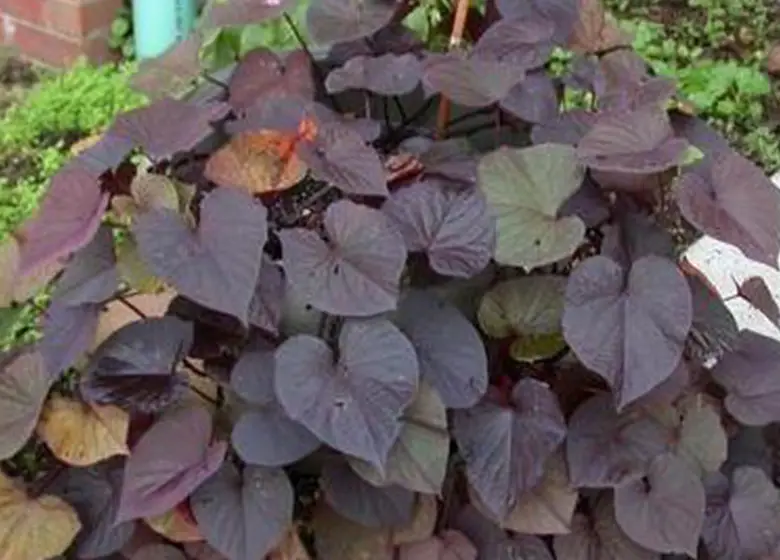
Ornamental sweet potato vine (Ipomoea batatas, USDA zones 8 to 11) are actually cultivars of the edible sweet potato but instead are grown for their colorful foliage. For example, ‘Margarita’ has lime-green leaves and the cultivar ‘Blackie’ sports blackish-purple leaves that are deeply lobed. Gardeners throughout the state can add these fast-growing, evergreen, perennial ground covers to their landscape. The long vines can grow around a foot tall and up to 10 feet long. In spring and summer, plants produce pink, funnel-shaped blooms that add even more interest to this vining groundcover.
Sweet potato vines will certainly dress us hanging baskets or containers, with its long vining branches covered in colorful foliage draping over the sides. It also works well used as a ground cover to fill in bare areas of the garden in a quick amount of time. Its tolerance to drought makes it useful in xeriscaping or rock gardens, as well as its moderate tolerance to salty conditions. The groundcover grows well planted in full sun to partial shade and in well-drained soils.
How to Choose the Best Ground Cover for Your Florida Yard
When selecting a ground cover that grows well in your Florida landscape, the main point is selecting the right plant for the right place in your yard. You can help conserve water just by grouping like plants together that have the same moisture requirements. Additionally, you can also help the local wildlife by selecting plants that attract beneficial pollinators or feed local bird populations. This helps in achieving a Florida-friendly landscape.
Before running to the store and purchasing ground covers, it’s best to analyze your landscape’s environmental conditions. This allows you to select plants that will thrive in the location and be low-maintenance. You don’t want to plant something that requires full sun in an area that only receives shade throughout the day.
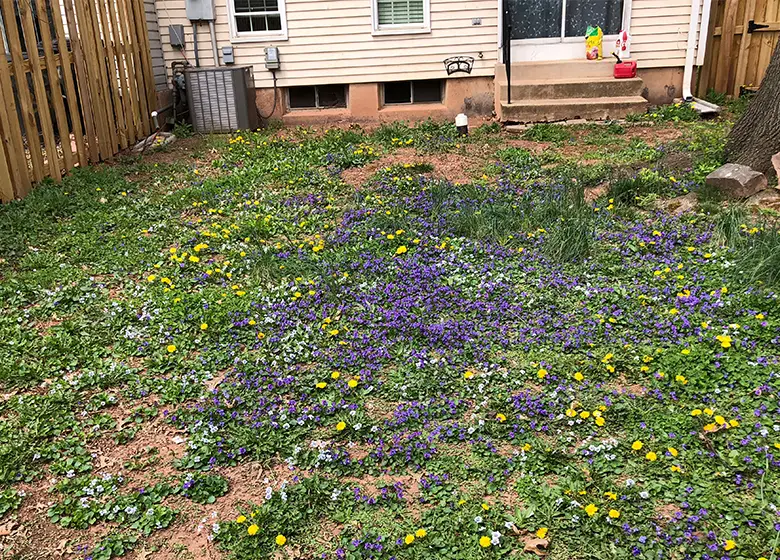
Familiarize yourself with the climate in your location, as well as the type of soil where your new ground covers will live. Is it well-drained or has a tendency to become soggy?
Also check out how much sunlight the area receives during the day. Depending on where you reside within the state, some plants requiring full sun will appreciate and still thrive in a location receiving a bit of shade during the hottest portion of the day during the afternoon.
Once you know what your site offers the proposed ground cover, you can then select a plant that will thrive in the area and not become a problem child because the cultural conditions aren’t to its liking. Research what the proposed ground cover prefers when it comes to light, soil and moisture needs. This assures a problem-free ground cover that won’t have you spending countless hours trying to keep it heathy and thriving.
Best Ground Covers for Shady Spots in Florida
If you have a shady spot in your Florida landscape don’t despair because there are a variety of plants that grow well in the darker light conditions. In fact, most thrive in the shadier conditions and won’t grow well in full sun.
You can define shade as an area that receives four hours of sunlight per day only receiving it in the morning and/or later in the afternoon, the area is bright but doesn’t receive direct sunlight and those that receive dappled shade throughout the day.
Of the ground covers noted above, bromeliads, mondo grass, sweet potato vine, sunshine mimosa and Minima jasmine thrive in shadier conditions. A few other plants that grow well in Florida and in a shade garden growing as a ground cover include:
- Creeping Phlox (Phlox subulate): Hardy in USDA zones 3b to 10, native blooming with white, pink, lavender or red flowers in spring. Tolerates partial shade to partial sun.
- Cast Iron Plant (Aspidistra elatior): Hardy in USDA zones 7 to 11, produces lush, tropical green foliage and thrives is partial shade to full shade.
- Maidenhair Fern (Adiantum spp.): Hardy in USDA zones 9 to 11, native producing fine and delicate green foliage and thrives in shade.
- Bugleweed (Ajuga reptans): Hardy in USDA zones 4 to 10, produces ruffled edges leaves in green with tinges of bronze and purple. Spring through summer, tall blue flower spikes form. Plants are hardy in partial sun to full shade.
Best Drought-Tolerant Ground Covers for Florida
Drought-tolerant ground covers won’t have you constantly in the garden giving everything a drink of water. They thrive in drier conditions and help you establish a Florida-friendly landscape. Plants that tolerate drought are perfect choices to add to a xeriscape or rock garden. If salt-tolerant, they can fill in bare areas in gardens located directly along the ocean, giving the landscape a touch of green.
From the above list of nine best ground covers for the state, beach sunflower, bromeliads, sweet potato vine, perennial peanut and juniper all stand up to drought conditions well. However, a few more ground covers that also grow well in gardens throughout the state and are drought-tolerant include:
- Twinflower (Dyschoriste oblongifolia): Hardy in USDA zones 8 to 11, produces lavender, funnel-shaped flowers year-round.
- Purple Lovegrass (Eragrostis spectabilis): Hardy in USDA zones 9 to 11, native blooming with purple flowers in spring.
- Creeping Fig (Ficus pumila): Hardy in USDA zones 8a to 11, evergreen with stems covered in tiny green leaves growing up to 40 feet long.
- Blanket Flower (Gaillardia pulchella): Hardy in USDA zones 3 to 11) native blooming summer through fall with daisy-like flowers in bi-colors, orange, red or yellow.
Fastest Growing Ground Cover for Florida
If you desire a ground cover to fill in a bare area quickly don’t fret because there’s a wealth of choices in fast-growing plants that thrive in Florida gardens. With many and before you know it, the area of bare soil will be covered in lush greenery.
Of the nine best groundcovers listed above Minima jasmine, sweet potato vine, perennial peanut and sunshine mimosa all grow quickly. Some other fast-growing ground covers hardy growing in the state include:
- English Ivy (Hedera helix): Hardy in USDA zones 4 to 9, evergreen producing 3 to 5 lobed green leaves.
- Railroad Vine (Ipomoea pes-caprae): Hardy in USDA zones 9 to 11, native blooming year-round with pink, funnel-shaped flowers and good for seaside gardens.
- Periwinkle (Vinca major): Hardy in USDA zones 7 to 9, produces large purplish-blue flowers in sum.
- Wandering Jew (Zebrina pendula): Hardy in USDA zones 9 to 11, long succulent stems with leaves striped in green and purple, purple insignificant flowers year-round.
You Might Also Be Interested In:
